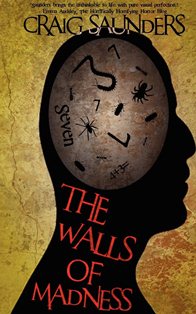
DLS Synopsis:
William Hunter is a thirty-year-old who sees things that others don’t. For the past two years he’s been tormented by the low beasts. Vile and repulsive insect-like creepy-crawlies that scutter out from behind the walls. And it doesn’t matter where Billy is, or what walls are around him; the Yik, the Krama and the Hatheth are always there, forever lurking behind the walls.
Diagnosed with a severe case of schizophrenia, and following his arrest and subsequent incarceration in a mental hospital, Billy has since been released and has been living out in the countryside next door to his seventy-year-old neighbour, Eileen Westwood. And Eileen has been good to him over this time.
Each night, when he wakes up screaming in his bed after seeing rodents crawling out from behind his walls, Eileen will put on her boots and venture over to his house to shoe the vermin away. Not that she can see them. But she does it anyway, to settle Billy down for the rest of the night.
But that December night, following his appointment at the community hospital where he met with Dr Richards for his usual hour of therapy, Billy has a night that goes beyond any of the horrors he has witnessed so far. A night where it is more than just mice and the low beasts that have crept through the walls to torment him. A night where their king, the Marlin, will come back to Billy, with more anger flooding through him than ever before.
Not even iron or the number seven can save him in the face of his tormentors. No one can help him, because no one believes that these horrors are real. Not even Eileen. But the screams coming through the wall of their adjoining houses must be real. And if Eileen can see them, and fear them, then perhaps they are more than just fabrication of his crazy mind. And then perhaps sometimes the nightmares can be real…
DLS Review:
Okay, so this is one freaky, disorientating and altogether messed-up novella. It’s pretty darn difficult to decipher what’s real and what’s just a figment of Billy’s schizophrenia. Indeed, the entire plight of the story is focussed upon Billy’s descent into his own private abyss, where he is plagued by visions of beasties and madness, and a dark man he has dubbed Marlin.
Instead of taking the reader along a linear course, the storyline instead jumps back and forth between the present (or a close approximation of it) and hazy recollections of the past. To be honest, it’s often not all that easy to place where the reader is in the course of Billy’s deeply troubled life. Indeed, the delivery is purposefully scattered and uncoordinated, creating a disorientating and surreal read that cleverly reflects the disjointed mind of Billy.
Author, Craig Saunders, clearly has a plan in mind. From the outset, you know that there must be something behind the madness. A vague hope of reasoning or a hint of an explanation. Something for the reader to finally grasp onto and have some form of understanding about. But before we get there, we need to experience the hell that Billy has been and continues to endure. A private and personal hell, where escape is only brief and never really lasts.
Furthermore, Billy’s therapy is a bittersweet pill which opens up the chaos and shows the reader more of the madness inside Billy’s troubled mind. Sessions are all too brief and infrequent; opening up the doors for a temporary respite, but never really solving any of the issues.
And what works so well with the novella is Saunders’ devotion to blurring the void between reality and hallucination. The world is a room where the doorway to Billy’s nightmarish visions is constantly ajar. They’re always lurking there, whether they really are behind the walls or merely at the back of his mind. It’s not really all that important which it is because to Billy, sadly they’re one and the same.
Although it’s a chaotically disorientating read, the novella isn’t altogether without elements of dark humour. Madness often inspires a nervous comedy – with its surreal take on reality, or its questionable response to day-to-day events. And to watch this in a voyeuristic fashion can bring some light relief to an otherwise circling mess of madness and mayhem.
The downright brave originality of the novella along with its utter avoidance of any constraining boundaries, are together what make the story work so very well. And it’s within the spiralling chaos that the reader can attempt to put the visual imagery together to form some larger, more identifiable picture, from the surreal jigsaw puzzle that is the entire storyline.
Admittedly, the novella isn’t an entirely satisfying read. After piecing together what you can, and glimpsing the sad reasoning behind the madness, there still seems to be a resounding void left behind where the bridge between the safe harbour of reality and the circling mess of schizophrenia is never truly established. And I can’t deny that this final vagueness isn’t something of a shame. The reader has followed Billy through the chaos and the cruelty, into nightmares and troubles from the past; and at the end of it all, there’s no real resolve. But then, perhaps that is the final reality of its lasting horror. The madness is always there. Lurking at the back of the mind, or indeed, behind the walls.
The novella runs for a total of 149 pages.

© DLS Reviews






